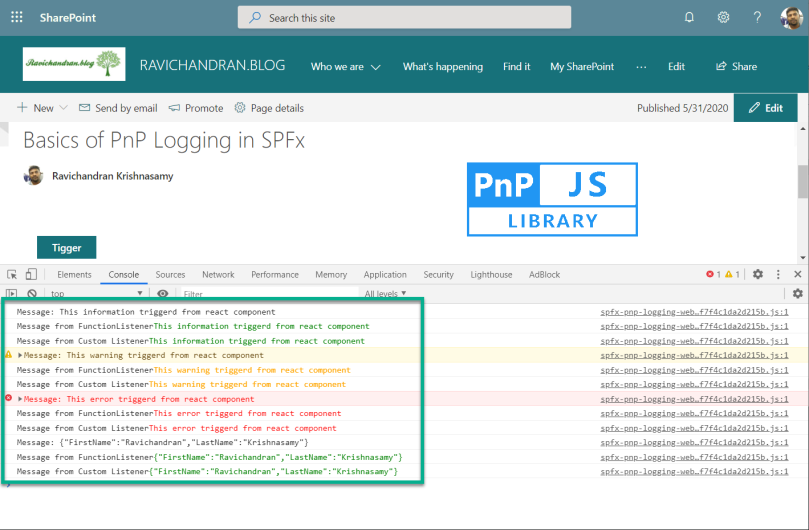This article provides steps to implement logging functionality using PnP Logging module in the SharePoint Framework (SPFx). Generally, The logging module provides a lightweight subscribable and extensible logging framework. This article basics of how to set up logging and how to use the various listeners.

Create a new web part project
Open power shell and run following comment to create a new web part by running the Yeoman SharePoint Generator
yo @microsoft/sharepointWhen prompted:
Enter the webpart name as your solution name, and then select Enter.
Select Create a subfolder with solution name for where to place the files.
Select Y to allow the solution to be deployed to all sites immediately.
Select N on the question if solution contains unique permissions.
Select WebPart as the client-side component type to be created.
The next set of prompts ask for specific information about your web part:
Enter your web part name, and then select Enter.
Enter your web part description, and then select Enter.
Select React framework as the framework you would like to use, and then select Enter.
Start Visual Studio Code (or your favorite code editor) within the context of the newly created project folder.
cd .\web part name\
code .Install the library and required dependencies
npm install @pnp/logging --saveRelated articles : Track SPFx logs using PnP Logging and Azure Application Insights
logger
The logger is the middle layer of our messages and listeners, we sending messages to the logger, so logger distribute to all listeners. so listeners should subscribe in order to receive a message from the logger.
Listeners
Basically receive the message from the logger. we can have any number of listeners, Inside the listeners, we can write code to store log messages into the Azure or SharePoint list or just writing in browser console with some customization
| Listener Type | Details |
|---|---|
| ConsoleListener | Just writes into the browser console, we can not customize anything |
| FunctionListener | We have full control, we can customize. also can write the code to save anywhere like azure or SharePoint |
| Custom Listener | same like FunctionListener, instead of the function we using class, so we can use all the advantages of class |
Client side web part class
We have to import and initialize the logging in the client side web part class we can access this logging feature in any of your react component. in the below code we have created FunctionListener and Custom Listener, also we have subscribed all the Listeners in the init event
import * as React from 'react';
import * as ReactDom from 'react-dom';
import { BaseClientSideWebPart } from '@microsoft/sp-webpart-base';
import SpfxPnpLogging from './components/SpfxPnpLogging';
import {
Logger,
ConsoleListener,
FunctionListener,
ILogEntry,
ILogListener,
LogLevel
} from "@pnp/logging";
const functionlistener = new FunctionListener((entry: ILogEntry) => {
if (entry.level == LogLevel.Error)
console.log('Message from FunctionListener%c' + entry.message, "color:red;");
else if (entry.level == LogLevel.Warning)
console.log('Message from FunctionListener%c' + entry.message, "color:orange;");
else if (entry.level == LogLevel.Info)
console.log('Message from FunctionListener%c' + entry.message, "color:green;");
else
console.log('Message from FunctionListener%c' + entry.message, "color:blue;");
});
class CustomListener implements ILogListener {
log(entry: ILogEntry): void {
if (entry.level == LogLevel.Error)
console.log('Message from Custom Listener%c' + entry.message, "color:red;");
else if (entry.level == LogLevel.Warning)
console.log('Message from Custom Listener%c' + entry.message, "color:orange;");
else if (entry.level == LogLevel.Info)
console.log('Message from Custom Listener%c' + entry.message, "color:green;");
else
console.log('Message from Custom Listener%c' + entry.message, "color:blue;");
}
}
export default class SpfxPnpLoggingWebPart extends BaseClientSideWebPart<any> {
public onInit(): Promise<void> {
Logger.activeLogLevel = LogLevel.Info;
Logger.subscribe(new ConsoleListener());
Logger.subscribe(functionlistener);
Logger.subscribe(new CustomListener());
return Promise.resolve<void>();
}
public render(): void {
const element: React.ReactElement<{}> = React.createElement(SpfxPnpLogging);
ReactDom.render(element, this.domElement);
}
}
React Component Class
In the react component class file we have triggered some of the log messages to the logger
import * as React from 'react';
import styles from './SpfxPnpLogging.module.scss';
import { PrimaryButton } from 'office-ui-fabric-react/lib/Button';
import {
Logger,
LogLevel
} from "@pnp/logging";
export default class SpfxPnpLogging extends React.Component<{}, {}> {
public render(): React.ReactElement<{}> {
return (
<div className={styles.spfxPnpLogging}>
<PrimaryButton onClick={this.btnclicked} text="Trigger"></PrimaryButton>
</div>
);
}
private btnclicked() {
Logger.write("This information triggerd from react component");
Logger.write("This warning triggerd from react component", LogLevel.Warning);
Logger.write("This error triggerd from react component", LogLevel.Error);
Logger.writeJSON({ FirstName: "Ravichandran", LastName: "Krishnasamy" }, LogLevel.Info);
}
}
Deploy the solution
You’re now ready to build, bundle, package, and deploy the solution.
Run the gulp commands to verify that the solution builds correctly.
gulp buildUse the following command to bundle and package the solution.
gulp bundle --ship
gulp package-solution --shipBrowse to the app catalog of your target tenant and upload the solution package. You can find the solution package under the sharepoint/solution folder of your solution. It is the .sppkg file. After you upload the solution package in the app catalog. you can find and the web part anywhere across the tenant.
Sharing is caring!
If you have any questions, feel free to let me know in the comments section.
Happy coding!!!


[…] Related articles : Basics of PnP Logging in SPFx […]
LikeLiked by 1 person